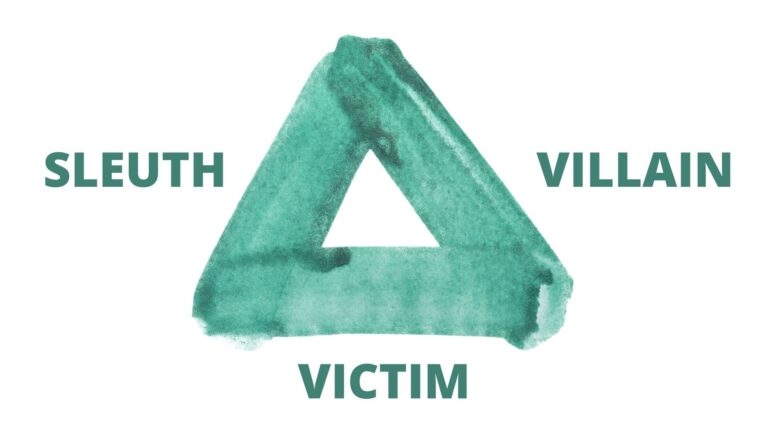The Detective Takes It On – Into Act II
Meeting The Possibilities
Here’s where focusing on story rather than fitting scenes into a form can help you successfully build a story that readers like. You’ve involved them in the story got them experiencing your protagonist with empathy, and in a mystery involved them in looking at the clues and suspects with a discerning eye, at least through the eyes of your detective.
In Act II you take your eager readers by the hand to journey through all the steps and missteps your detective takes. When a suspect comes with new insights into the victim, or the opponent throws up a barrier, you reader is ready to keep going wherever your detective goes as long as you focus on moving the story forward.
Now, your protagonist has committed herself to unravelling the threads. In Act II you add new twists to the threads and tie some of them in knots. When you keep the focus on the story you’ll avoid that episodic feeling with no rising tension that can mark you story as a first “attempt” at novel writing.
19:52 Q: I’m starting in on my mystery. I’ve heard that authors need to learn marketing. Is that right?
21:41 Q: I love reading crime novels and want to try my hand. I have an idea but don’t know anything about the inner workings of a police department. Any suggestions?
Resources:
Mark Dawson’s Self Publishing 101.
Sergeant Derek Pacifico’s The Writer’s Guide to Homicide. The mystery writers’ textbook on murder and policework.
Writers Detective Bureau
FBI for writers
Trips and Stumbles In The Old Vision
Chapters 11 through 15 of the 40 Sentence Outline focus on your protagonist and the trips and stumbles he makes as he sets out to solve the puzzle. He learns more about the victim’s world, but not enough.
11 Your protagonist immediately stumbles on unfamiliar terrain—everything feels different here, even if it looks the same: new rules, new problems, new dangers. As he dusts himself off, his insecurities sing a song of future failure.
Your detective stumbles. The plan she devised doesn’t fit the circumstances. A new problem or dangers upset the plan. She feels stumped…for the moment. The pivot she just took slammed her into a wall.
Want to know where this is in traditional plot? This is the aftermath of the first plot point.
12 Moving onward, he meets a representative of this extraordinary world—the antagonist, a minion, a mentor, a former ally or enemy who’s comfortable here, or maybe even a random stranger who embodies the spirit of this place. Your protagonist starts to understand the new yardstick that he will be measured by here, and that he’d underestimated the dangers he’ll face. (Subplot B)
Your detective finds an unexpected ally that tells him more about the victim’s world. He starts to understand the complications of taking on the murder investigation. This could be the enticing new love interest or a new character. Speaking of that love interest, this is a good place for them to meet again.
Where are we in traditional plot? This is the second complication.
13 Your protagonist plots what he thinks will be a safe course through the extraordinary world, recruiting whatever allies and resources he can, and sets off in a new direction. (Subplot A)
Armed with his new understanding your detective explores the new knowledge, connects clues and suspects with his new understanding, and starts to pursue his new course. Meanwhile his opponent is challenging his moves not knowing what the detective now nows.
In plot speak, this is the aftermath of the second complication.
14 He seems to be making progress…yeah, he was freaking out, but now that he’s getting the hang of this place, maybe it’s not going to be as bad as he thought. The new world throws a problem at him, and he handles it almost competently (or was that beginner’s luck?).
Back on stride, your detective follows clues, successfully interviews suspects and gets a better picture of the victim’s world and how they moved in that world. If your detective entered the victim’s world, she’s starting to get the lay of the land.
Over in plot land, this is the setup for the first pinch point.
15 Crossing paths with the antagonist—or stumbling into a mess that the antagonist has left behind—your protagonist is taken off guard. He gets a glimpse of the antagonist’s true power for the first time, and realizes he’s in completely over his head as he takes significant damage.
Your detective discovers there’s more to the murder than he first thought. A discovery – clue, evidence, suspect – reveals a whole new perspective on the murder victim and opens up possibilities he hadn’t seen. He’s out of his depth, baffled, and knocked off center.
Plot time equals first pinch point.
Expand the Story
Going deeper into your story gets readers turning pages. Each new problem your protagonist faces keeps readers guessing in your mystery. In this part of the story the focus is on unrelenting problems, the detective’s discovery of the victim’s world, and tests of the detective’s know skills.
Take your time to bring the reader and the detective into the victim’s world. This is the place where you expand your story. Develop the victim’s world. Spotlight suspects. Use clues to take your detective down a wrong path. Bring your research and worldbuilding skills to play to create an environment that is new to the detective and to your readers. If you’ve done your pre-planning by developing secrets for each suspect and the lies they create to hide the secrets, it’s time to play with them as you bring those secrets into your story.
Zara Altair
Zara Altair writes mysteries set in ancient Italy. Her course for beginning writersWrite A Killer Mystery is coming soon. Get on the notification list.



